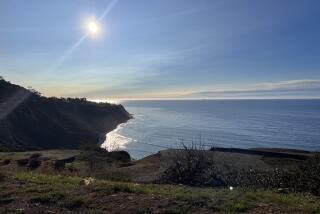Despite safeguards, peril of night flying is noted in midair collision
SAN DIEGO AND LOS ANGELES — Electronic warning systems and a computerized “notice to all airmen” system exist to prevent midair collisions like the one Thursday night off San Clemente Island that apparently killed nine military members.
But as a Coast Guard admiral noted ruefully Friday, “No system is perfect.”
Even in an age of sophisticated collision-detection warning equipment, communication gear and an instantaneous message board notifying all pilots of military maneuvers, the fundamental safety procedure remains “see and avoid.”
Night flying is fraught with particular peril, as pilots become more focused on their cockpit instruments. Even veteran pilots can look up and see other craft dangerously close.
“We’ve all had those surprises where your heart jumps,” said James Huston, a San Diego lawyer, author and former Navy fighter pilot.
The collision between a Coast Guard C-130 Hercules transport plane and a Marine Corps AH-1 Super Cobra helicopter occurred about 7:10 p.m., 20 miles east of San Clemente Island. A nearby pilot reported a fireball in the sky.
The Coast Guard plane from Sacramento, with seven crew members, was searching for a 12-foot skiff reported adrift near the island, which is owned by the Navy.
The Super Cobra, with two pilots, was among four Marine helicopters from the Miramar Marine Corps Air Station-based 3rd Marine Aircraft Wing on a night training mission.
The Coast Guard plane, designed for search-and-rescue missions, departed Sacramento about 3:30 p.m. and arrived at the search site about 75 minutes later. With darkness, the four Marine helicopters headed for their training mission off San Clemente Island.
Pilots can post a “notice to all airmen” on a system run by the Federal Aviation Administration. It is customary to post such notes when the military is conducting either a training or search-and-rescue mission, said Huston, who has handled military helicopter crash litigation.
On the notification system, the location of missions is visible to all aircraft. It is unclear whether the Coast Guard or Marine Corps posted such a note about their missions near San Clemente Island.
The collision occurred at 900 to 1,000 feet altitude, Coast Guard Rear Adm. Joseph Castillo told reporters in San Diego.
A Pentagon spokesman said it was unlikely that anyone survived. Still, Castillo refused to give up hope, noting that all the personnel are in good physical condition and trained in water-survival techniques.
“We will continue to search as long as there is a chance of survivors,” he said.
Search efforts by the Navy, Coast Guard and Border Patrol in a 644-square-mile area were expected to continue throughout the night Friday.
Castillo said the Coast Guard and Marine Corps will do a joint investigation to determine the cause of the collision and how similar incidents can be avoided.
The Coast Guard plane on its flight from Sacramento was in touch with FAA controllers. As it neared San Clemente Island, procedures called for it to notify the North Island Naval Air Station in Coronado, Calif.
The Coast Guard was searching for a small boat piloted by David Jines, 50, who lives on Santa Catalina Island and had gone to assist another boater. That boater returned safely but Jines remained unaccounted for.
An FAA spokesman said that controllers had told the Coast Guard pilot to contact North Island as it approached the San Clemente Island airspace. It is unclear whether that notification was made.
Meanwhile, FAA controllers never talked to the four Marine helicopters, the FAA spokesman said.
In San Diego and Sacramento, families of the crew members waited anxiously for news of a possible rescue. The Coast Guard estimated survival time in the water as approximately 20 hours.
In San Diego, where many former pilots make their home, the crash renewed their appreciation of the dangers of flying.
“When I hear about something like this, I get a knot in my stomach,” said Dave Koontz, a retired Navy officer who flew CH-53 helicopters.
Huston, whose latest novel, “Marine One,” is about the fatal crash of a helicopter carrying a U.S. president, said that even with advanced equipment, there is still the ever-present chance of human error.
“It’s the rule you learn on Day 1 of flight school: ‘Don’t assume the other guy is doing the right thing,’ ” he said.
--
dan.weikel@latimes.com
More to Read
Sign up for Essential California
The most important California stories and recommendations in your inbox every morning.
You may occasionally receive promotional content from the Los Angeles Times.










